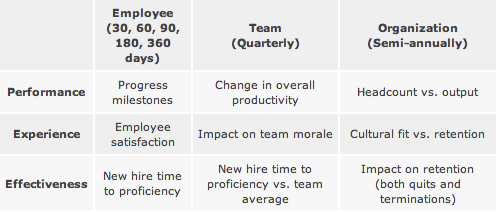Organizations invest a lot in their workforce, and it’s no surprise that they expect to see a return on their investments (ROI). But as business leaders look for the best ways to maximize the ROI of their workforce, the onboarding process is often overlooked. For many, the onboarding experience is reduced to a mere checklist of tasks to be completed and forms to be submitted. The fact that such organizations fail to understand, though, is that an employees that experience a smoother onboarding process will be more connected to the organization, better trained and, thus, quicker to produce.
The key to making the case for future resource allocation lies in being able to illustrate the effectiveness of your onboarding process. Your decision-makers need to know their resources are being put to good use. With the right metrics at your disposal, you can deliver the information they’re looking for.
Establish a Baseline for Measuring Onboarding ROI
Many HR departments struggle to establish a baseline for how their organization will assess ROI. Evaluating the value of an enhanced HR process is not always a straightforward process, but establishing a baseline is the first and most important step. Spending time with leadership and defining your standards for measuring ROI is invaluable.
When establishing your baseline to measure ROI, there are a few key concepts you should keep in mind:
- Onboarding should be consistent. All of your fancy data gathering will be for naught unless you can roll out a universal process for onboarding new hires.
- The onboarding process is more than a checklist. Though checklists are great for staying organized, your new hires’ success depends on your ability to get them connected to your organization and keep them connected beyond their first day.
- The onboarding process goes beyond the first week.reports 22 percent of staff turnover occurs in the first 45 days of employment.
How to Brave the Metrics Madness
After identifying what information will be most valuable, you can begin strategically tracking data. Keep in mind that some of the data you measure won’t be cold, hard facts that fit nicely into a spreadsheet. Don’t let this frighten you! This is why you’ve established a baseline with leadership.
There are three areas you can focus on for information: performance, experience and effectiveness. In terms of scope, I’d suggest looking beyond your new hires. Measure the impact at various levels (team, department, organization). Here are a few ideas of what you can measure (as well as how frequently):

For Maximum ROI, Take Engagement Beyond Onboarding
The best metrics should be forward-thinking analytics tools. According to Dr. John Sullivan at TLNT.com, “They tell you who’s going to win the Superbowl next year, not who won last year.” Furthermore, they should provide the information you need to win the Superbowl every year.
At the end of the day, your ROI is answering one question above all: What is the value of onboarding new employees more effectively? Here’s a hint: Take a look at your metrics and note improvements in employee performance, time to proficiency and increased retention. Once you can answer that question, move onto the next question: “How can we maximize the value of a better-onboarded employee?”
One way you can maximize this value is to keep the momentum going. Many organizations leverage the tools and technology found in talent management systems such as Lawson Talent Management to better manage the process of engaging and motivating their employees. Beyond core talent management functionality, these systems also offer reporting analytics and dashboard elements that provide the information you need to support your ROI analysis.







